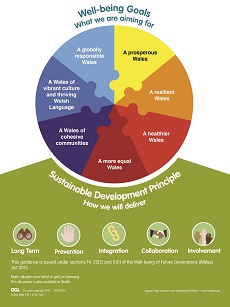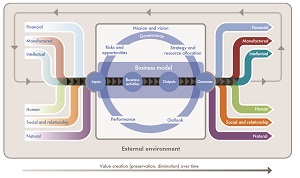Feature / Integrated thinking and reporting
There is widespread recognition that the NHS is not sustainable in its current configuration. The population is expected to increase to 74 million by 2039 with nearly one in eight of us predicted to be 75 or over and one in 12 aged 80 or older.
With increased life expectancy, the health system increasingly needs to support more people living with illness. The challenges faced by the NHS cannot be addressed in isolation with clear interconnections between services such as health, housing, social care and education. If we are going to target holistic improvements, we need to think in whole systems. It is clear we all need to be doing this, yet how do we move this ideal forward?
We are already seeing signs of looking beyond working as an isolated NHS and engaging with all contributors. Emerging examples include health and wellbeing boards and sustainable transformation footprint areas in England, fully integrated health and social care in Northern Ireland and Scotland’s integrated joint boards and community planning partnerships. Yet, arguably Wales is further down the line in thinking this through, with the Well-being of Future Generations Act (Wales) 2015 challenging all public bodies to individually and collectively work towards a legally-binding common purpose.
Wales does not come at this initiative from a standing start. Value-based healthcare – considering outcomes relative to costs – is being pursued in some areas and provides a good mechanism for thinking through and setting objectives, particularly in terms of outcomes, to meet the requirements of the act.
Guidance on the act also suggests that integrated reporting – an approach pioneered in the commercial sector and being explored by the Welsh government – could offer a way of reporting on progress. This proposal has prompted the HFMA to take a closer look at the reporting tool with the aim of publishing a briefing towards the summer.
Wellbeing act
The Welsh act aims to improve social, economic, environmental and cultural wellbeing in Wales. The challenges faced by Wales now and in the future are not unique. However, Wales is different in using explicit legislation as a framework to address them.
The act recognises that no one body can address these challenges alone. Its intention is to make public bodies think about the long term, work better together and look to prevent problems.
According to Sophie Howe, the future generations commissioner for Wales, the act provides ‘the encouragement, the permission and statutory obligation to make these
changes’. It establishes seven wellbeing goals to create a shared vision (see figure 1 below). Public bodies are then required by a statutory duty to set wellbeing objectives to maximise the contribution to these goals. In taking reasonable steps to meet these objectives, they must also apply the sustainable development principle in what they do.
In the context of the act, sustainable development is about ensuring the needs of the present are met without compromising the ability of future generations to meet their own needs. More specifically it means:
- Looking to the long term so that we do not compromise the ability of future generations to meet their own needs
- Taking an integrated approach so that public bodies look at all the wellbeing goals in deciding on their wellbeing objectives
- Involving a diversity of the population in the decisions that affect them
- Working with others in a collaborative way to find shared sustainable solutions
- Understanding the root causes of issues to prevent them
 from occurring
from occurring
Public bodies had to produce wellbeing objectives by the end of March and will need to review progress annually. Public service boards (PSB), created by the act and made up of a range of specified public bodies, are also required to undertake a wellbeing assessment by this May, with a further year to produce a wellbeing plan.
Rather than creating additional requirements, the act aims to provide a different context within which priorities can be reviewed and rethought. Early signs are that public bodies have reviewed their existing strategies through the lens of the act and produced wellbeing objectives, agreed by their boards.
Organisations will need mechanisms to assess, achieve and report against their objectives. Future planning processes will also need to be aligned with the act. This will apply to a number of processes including budget planning, communication and engagement, risk management, data gathering and monitoring, decision-making and reporting.
There are major links between this wellbeing agenda and value-based healthcare. Value-based healthcare aims to look at outcomes in the round, focusing on the outcomes that matter to patients rather than activity-based outputs.
It pushes organisations to look across the whole care cycle – considering the impacts of changes in secondary care on community services, for example. And it also overtly takes account of the costs of providing services. It is an evidence and data-driven approach and offers a robust way of establishing objectives to meet the wellbeing goals.
In Wales, a strategic alliance with the International Consortium on Health Outcome Measurement (ICHOM) is looking to establish an agreed set of standard outcome sets for several conditions, potentially providing a foundation for wellbeing objective setting.
Once objectives have been set based on delivery of the right outcomes that maximise the contribution to the wellbeing goals, public bodies are required to report annually on progress. Guidance on the act – Shared purpose, shared future – suggests integrated reporting could help organisations discharge this communication duty.
Integrated reporting
Integrated reporting or IR has been developed primarily in the commercial sector and is now being explored by the Welsh government. NHS bodies already report annually on performance. Integrated reporting would push them to report on how they manage their resources and relationships (referred to as ‘capitals’) to create value over the short, medium and long term.
There is an explicit recognition that not all aspects of the value of an organisation can be accounted for in financial statements. In taking this holistic view, it fits well with the aims of the act and value-based healthcare.
A published IR framework defines the ‘capitals’ that should be considered as: financial; manufactured (which might be translated as ‘infrastructure’ in the public sector); intellectual; human; social and relationship; and natural – although only those that are material should be included in an integrated report (see figure 2 below).
Accountancy body CIPFA and the International Integrated Reporting Council have published a guide to how integrated reporting might work in the public sector. It suggests an integrated report should use ‘quantitative and qualitative information to look at how the activities and capabilities of an organisation transform the relevant capitals into outcomes for the organisation and others’.
IR is not intended to be just another reporting initiative. Many organisations will already have existing information and processes in place, but IR could help focus on what matters most.
CIPFA’s guide suggests it could be ‘an umbrella that can encompass other standards and frameworks to help provide a more complete and coherent picture of value creation by an organisation’.
Early experiences suggest that the following steps are needed in making a move to IR:
- Identify/communicate the potential of IR Identify stakeholders, understand their needs and engage with them over what you are trying to achieve
- Get senior-level commitment to the approach
- Identify champions from across the organisation
- Involve all parts of the organisation in simply defining and understanding the strategy
- Understand and manage the risks
- Identify relevant capital and inputs/outputs
- Identify what information is required, how it can be measured and what you already have
- Set a realistic timetable and clarity over inputs, resources and outputs
- Allow time to reflect on year one of IR

The HFMA’s briefing will be looking at the practical insights from those already using the approach. Early signs are that those using IR have seen benefits internally and externally, yet the approach requires time to evolve and improve for each organisation.
IR has the potential to support organisations as they pull together the number of jigsaw pieces across complex organisations and systems. It offers an opportunity for public bodes to demonstrate how they are creating long term stability, restore trust and demonstrate different sources of value spanning borders, cultures and generations. As such its potential application reaches well beyond the Welsh borders.
Related content
We are excited to bring you a fun packed Eastern Branch Conference in 2025 over three days.
This event is for those that will benefit from an overview of costing in the NHS or those new to costing and will cover why we cost and the processes.